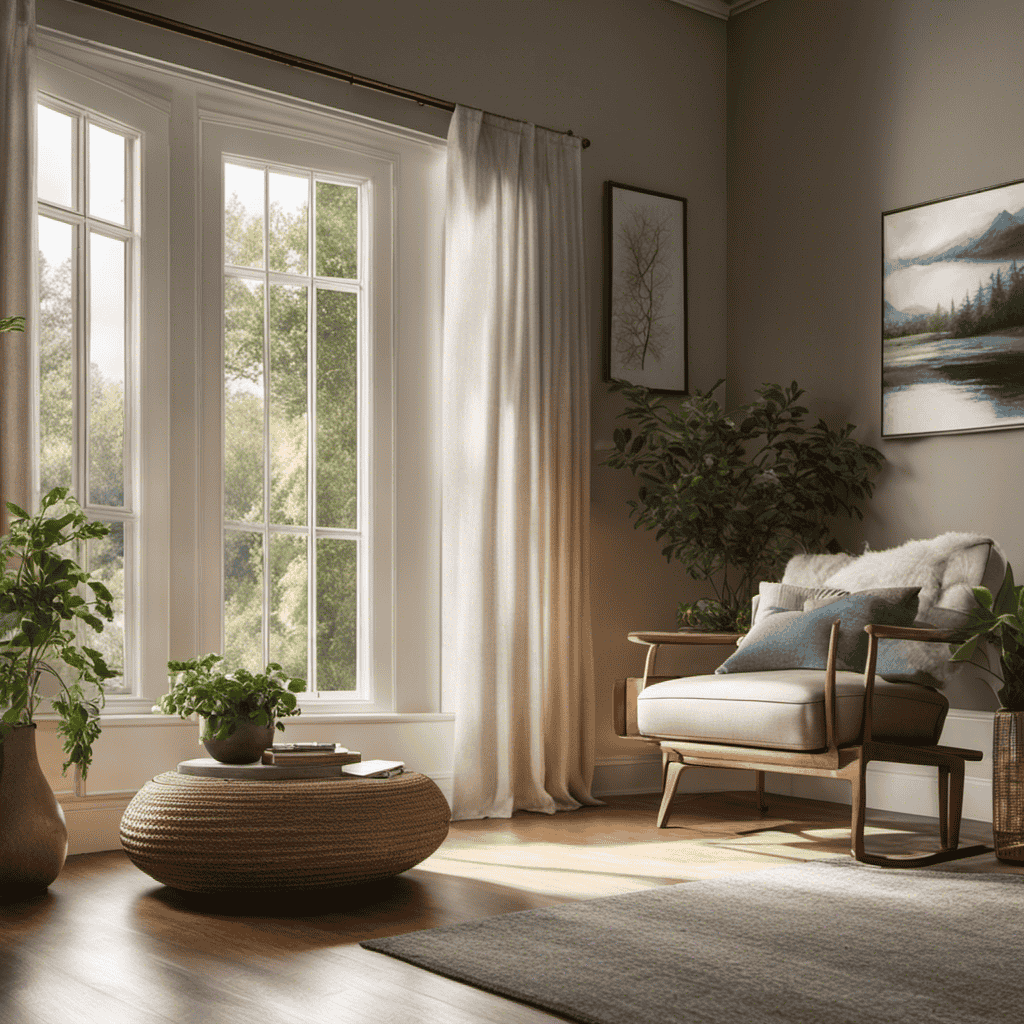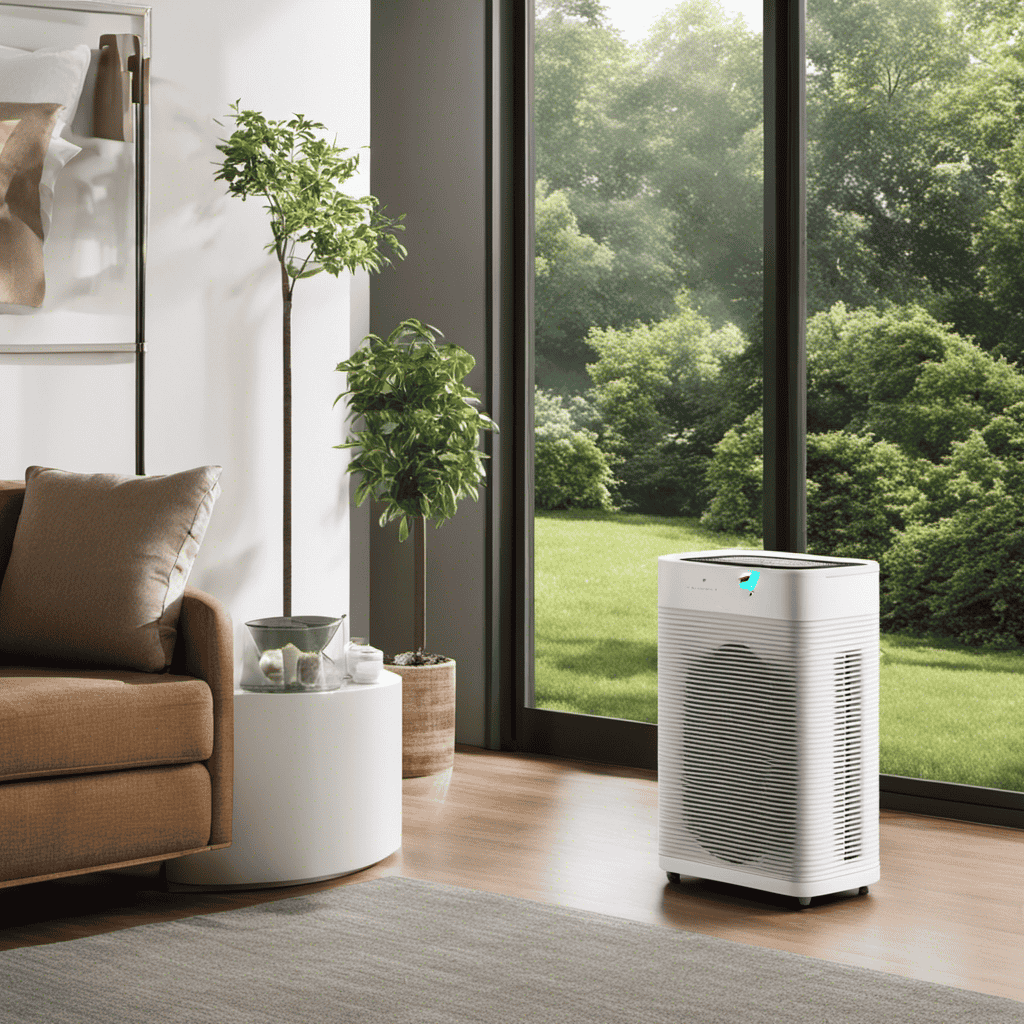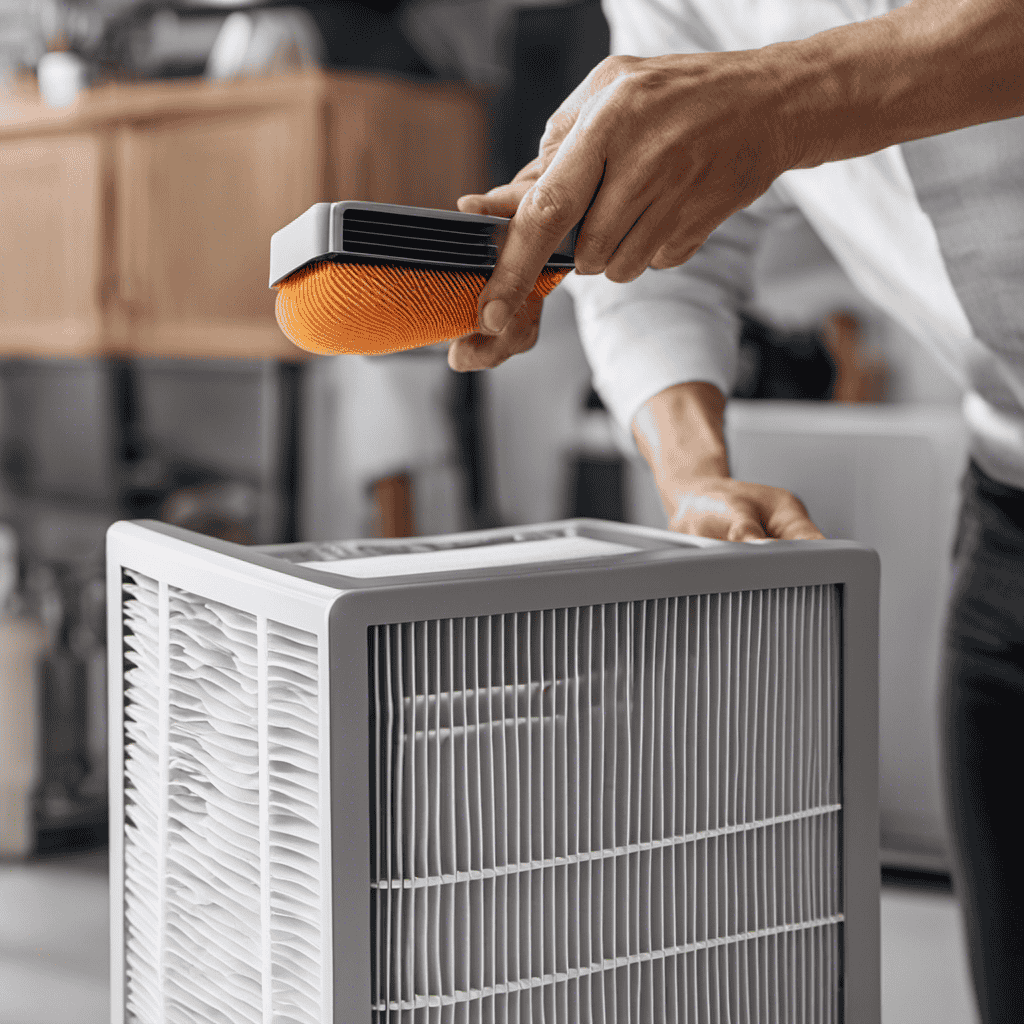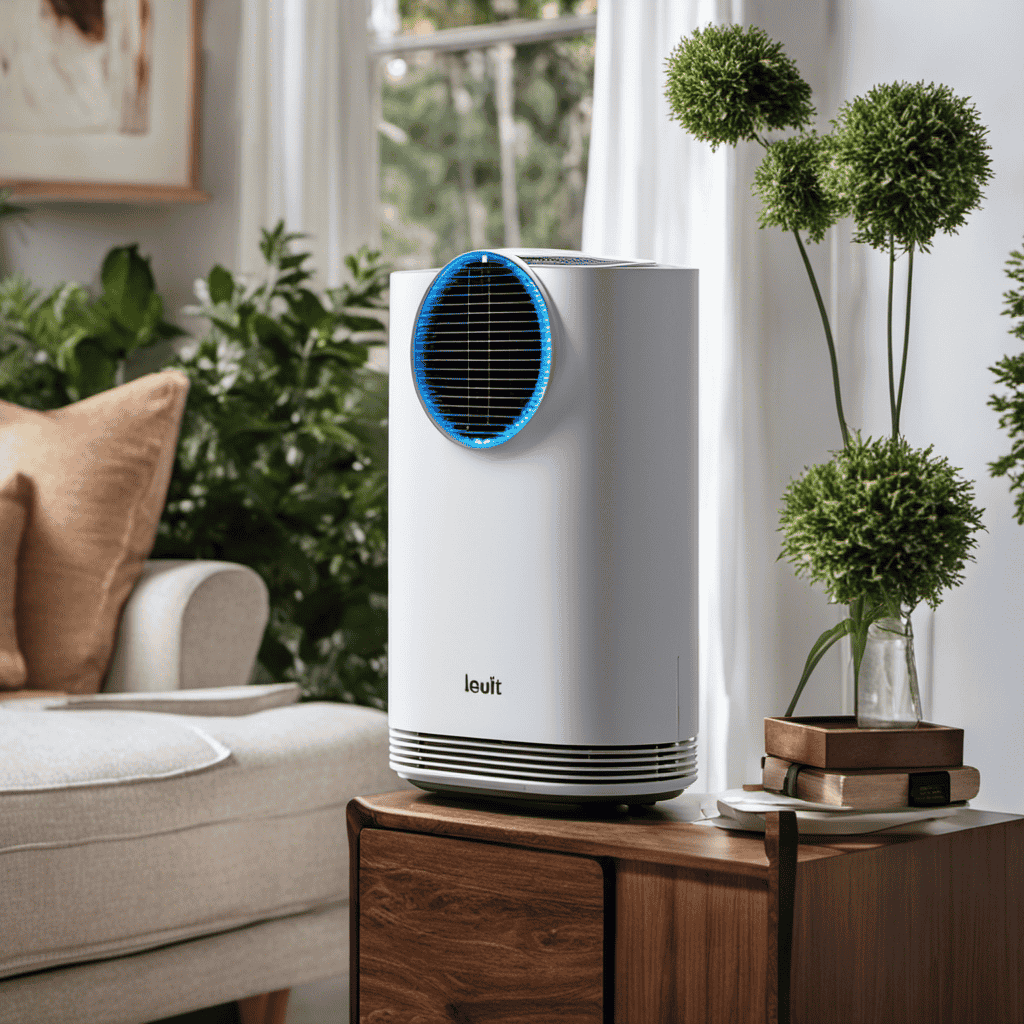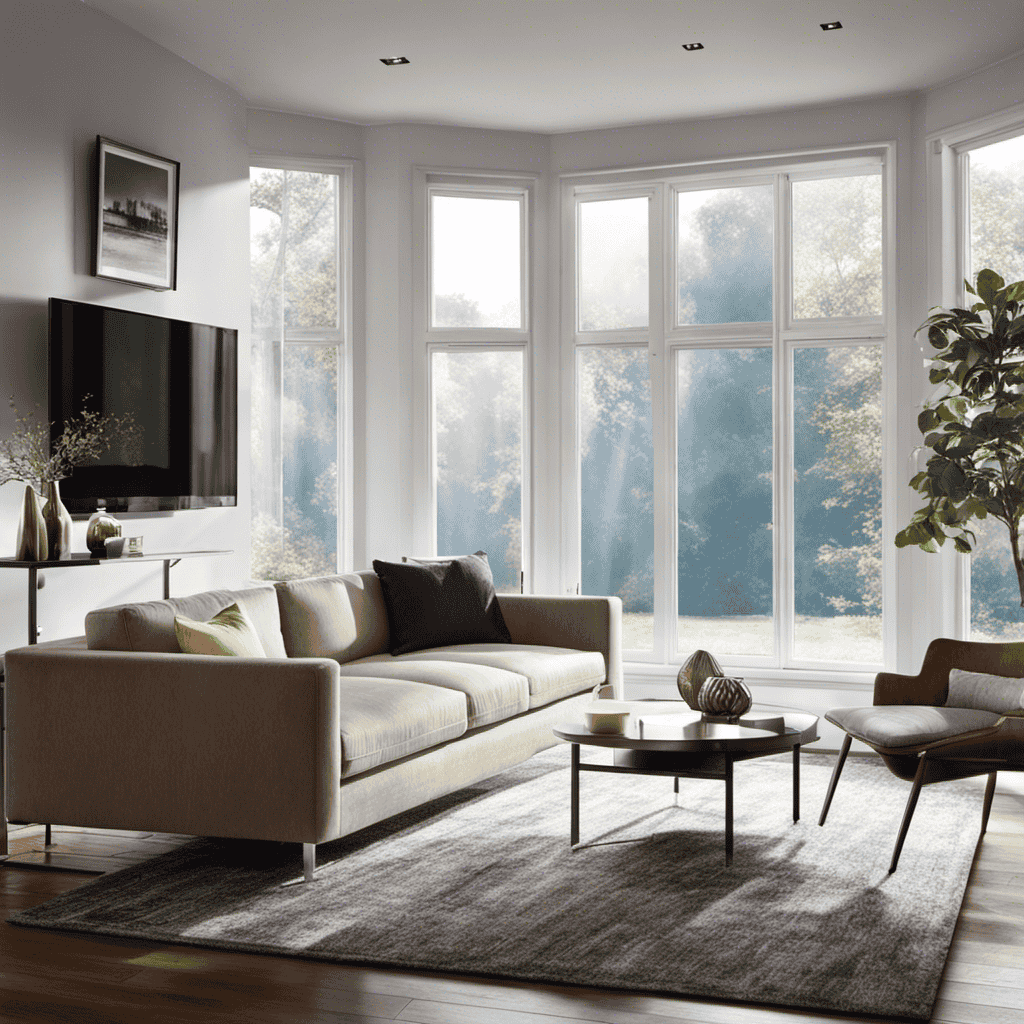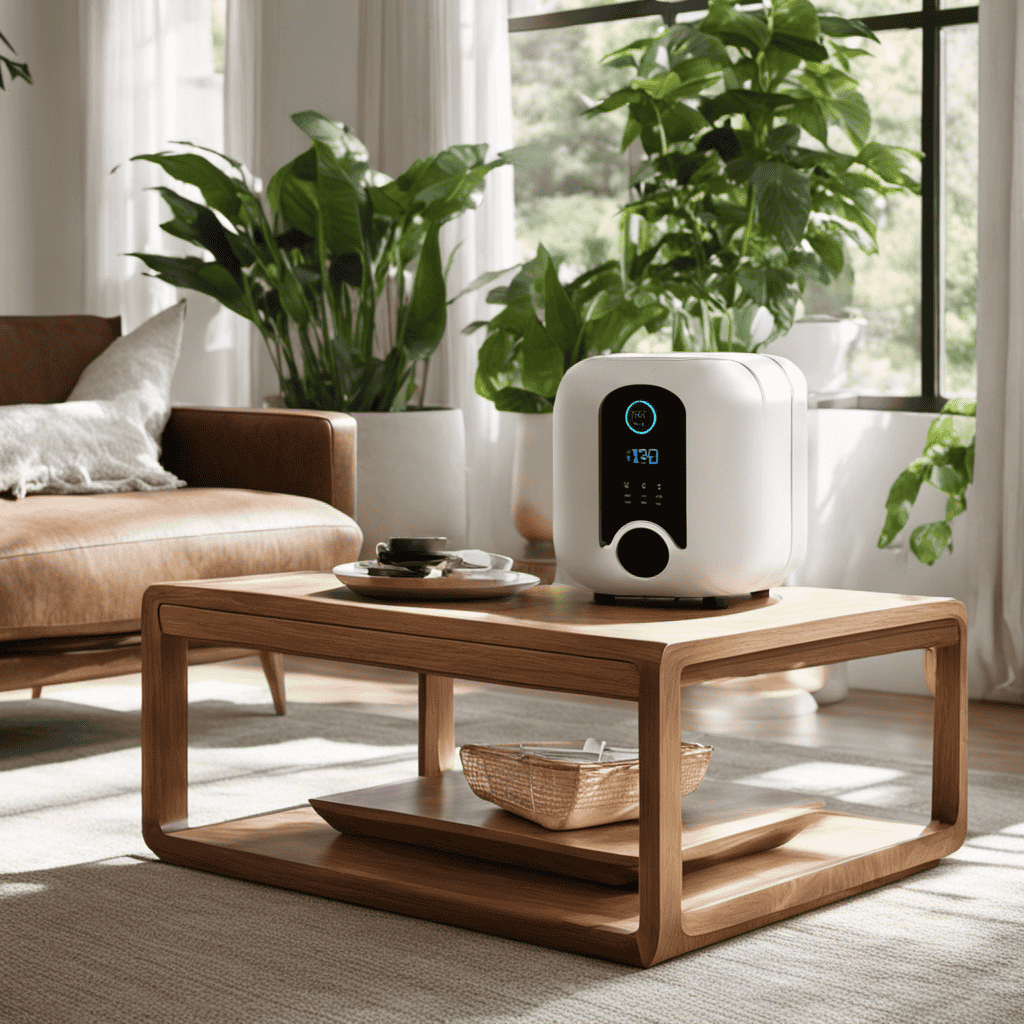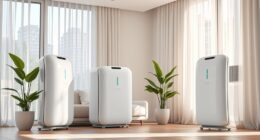As an individual who has consistently battled with allergies, I’ve frequently pondered the role of an air purifier in enhancing the quality of indoor air. Let me share with you – these gadgets truly do miraculous work!
They actively filter out dust, allergens, and even odors, making the air you breathe cleaner and fresher. With the help of HEPA filters, air purifiers are able to trap and remove even the tiniest particles, like pollen and pet dander.
So, if you’re looking to improve your respiratory health and create a healthier home environment, an air purifier is definitely worth considering.
Key Takeaways
- Air purifiers actively filter out dust, allergens, and odors.
- HEPA filters trap and remove tiny particles like pollen and pet dander.
- Regular maintenance, including replacing the HEPA filter, ensures optimal performance.
- HEPA filters improve indoor air quality and reduce the risk of respiratory issues.
How an Air Purifier Filters Air
To understand how an air purifier filters air, you’ll need to know about its various components and how they work together.
One crucial component of an air purifier is the HEPA (High-Efficiency Particulate Air) filter. The HEPA filter is designed to capture and trap tiny particles, including dust, pollen, pet dander, and even bacteria and viruses. Its intricate web of fibers creates a maze-like structure that effectively captures these particles as air passes through.
The benefits of a HEPA filter are significant, as it can improve indoor air quality and reduce the risk of respiratory issues. However, it is essential to perform regular air purifier maintenance, including replacing the HEPA filter, to ensure its optimal performance.
Regular maintenance will help keep your air purifier running efficiently and effectively purifying the air in your space.
The Role of HEPA Filters in Air Purifiers
If you want cleaner indoor air, you’ll need an air purifier with a HEPA filter. HEPA stands for High Efficiency Particulate Air, and these filters are known for their effectiveness in removing a wide range of pollutants from the air.
HEPA filters are made up of a dense mat of fibers that can trap particles as small as 0.3 microns, which includes common allergens like pollen, pet dander, and dust mites. In addition, HEPA filters can also capture larger particles like mold spores, bacteria, and viruses, improving the overall air quality in your home.
The effectiveness of HEPA filters is backed by scientific research, and they are often recommended for individuals with allergies or respiratory conditions. So, if you are looking to eliminate harmful pollutants from your indoor air, investing in an air purifier with a HEPA filter is a wise choice.
Removing Dust and Allergens With an Air Purifier
I’ve found that air purifiers have multiple benefits. They not only remove dust and allergens from the air, but they also provide several health benefits. Air purifiers use a combination of filters, including HEPA filters, to effectively capture and trap particles as small as 0.3 microns. This reduces the presence of harmful pollutants in the air, leading to improved indoor air quality. This improved air quality can help alleviate symptoms of allergies, asthma, and other respiratory conditions.
Health Benefits of Purifier
Improve your respiratory health with an air purifier. It helps remove allergens and pollutants from the air you breathe. Air purifiers have numerous benefits for your health. One of the most important is ensuring clean air. Indoor air can be filled with harmful particles such as dust, pollen, pet dander, and mold spores. These can trigger allergies and respiratory problems, especially for those with asthma or other respiratory conditions. By filtering these particles, air purifiers reduce the risk of these health issues and improve overall air quality.
Breathing clean air is essential for maintaining good health and preventing respiratory diseases. With an air purifier, you can create a healthier environment for yourself and your family, promoting better respiratory well-being.
Now, let’s delve into the next section and explore the concept of improved indoor air quality.
Improved Indoor Air Quality
To enhance your indoor air quality, consider using an air purifier that effectively filters out allergens and pollutants. Here are three reasons why using an air purifier can greatly improve your sleep and reduce pollutants in your home:
-
Removal of Allergens: Air purifiers are designed to capture and eliminate common allergens such as pollen, dust mites, and pet dander. By removing these irritants from the air, you can experience a reduction in allergy symptoms, allowing for a more restful sleep.
-
Reduction of Airborne Pollutants: Air purifiers also target harmful pollutants like smoke, VOCs (volatile organic compounds), and airborne chemicals. By eliminating these pollutants, you can breathe cleaner air, which can promote better sleep and overall health.
-
Improved Air Circulation: Air purifiers help to circulate and filter the air in your home, preventing stagnant air and maintaining optimal air quality. This constant circulation can create a more comfortable and conducive environment for sleep.
By improving sleep quality and reducing pollutants, air purifiers play a crucial role in maintaining a healthy indoor environment.
Now, let’s explore how air purifiers can effectively eliminate odors.
Eliminating Odors With an Air Purifier
Eliminate those stubborn odors in your home with an air purifier. Air purifiers offer numerous benefits, including the ability to effectively eliminate household odors. These devices use advanced filtration systems to capture and remove odor-causing particles from the air, leaving your home smelling fresh and clean. The table below highlights some common household odors and the specific types of particles that air purifiers can target and eliminate:
| Odor | Particle Type |
|---|---|
| Pet Odors | Pet dander, hair |
| Cooking Odors | Smoke, grease particles |
| Tobacco Smoke | Tar particles |
| Mold and Mildew Odors | Mold spores, bacteria |
Reducing Pollen and Pet Dander With an Air Purifier
As an expert in air purification technology, I’d like to discuss the subtopic of reducing pollen and pet dander with an air purifier.
In this discussion, I’ll explore various allergen elimination methods. I’ll explain the health benefits associated with reducing these allergens and assess the efficiency of air purifiers in achieving this goal.
Allergen Elimination Methods
One way an air purifier helps with allergens is by filtering out particles that can trigger reactions. Here are three common allergens that an effective air purifier can eliminate:
-
Dust mites: These microscopic creatures are a major cause of indoor allergies. They thrive in warm and humid environments and their waste particles can trigger allergic reactions. An air purifier with a HEPA filter can capture these tiny allergens, reducing their presence in the air.
-
Mold spores: Mold can grow in damp areas such as bathrooms, basements, or areas affected by water damage. When mold releases spores into the air, they can cause respiratory issues and allergies. A high-quality air purifier can trap and remove these mold spores, providing relief to those affected.
-
Pollen: During certain seasons, pollen from trees, grasses, and flowers can enter your home and cause allergies. An air purifier with a pollen pre-filter can effectively capture these airborne particles, reducing their presence in the air you breathe.
Health Benefits Explained
Improve your overall well-being by reducing the presence of common allergens in the air you breathe. Air purifiers are highly effective at removing airborne allergens, providing numerous health benefits.
These devices work by drawing in the air and passing it through a series of filters that capture and trap particles such as dust, pollen, pet dander, and mold spores. By reducing the number of allergens in the air, air purifiers can alleviate symptoms of allergies and asthma, improve respiratory health, and enhance sleep quality.
Additionally, air purifiers can help eliminate harmful pollutants like smoke, odors, and volatile organic compounds (VOCs), contributing to a healthier indoor environment. With their proven effectiveness in reducing allergens and pollutants, air purifiers are an essential tool for promoting better health and well-being.
Now, let’s delve into the efficiency of air purifiers and how they work to clean the air in more detail.
Efficiency of Air Purifiers
Get ready to learn how air purifiers efficiently clean the air, removing harmful particles and improving the overall quality of the indoor environment.
Air purifiers are highly effective at capturing and eliminating various contaminants, such as dust, pollen, pet dander, mold spores, and even smoke particles.
Here’s why air purifiers are a great investment:
-
High-efficiency particulate air (HEPA) filters: These filters are capable of trapping particles as small as 0.3 microns, ensuring that even the tiniest pollutants are removed from the air.
-
Activated carbon filters: These filters excel at eliminating odors, volatile organic compounds (VOCs), and other chemical pollutants, making the air fresher and healthier to breathe.
-
Cost comparison: While the initial cost of an air purifier may seem high, it is important to consider the long-term benefits. Improved indoor air quality can lead to a reduction in health-related issues, medical expenses, and the need for frequent cleaning.
With air purifiers effectively cleaning the air, the next section will explore their role in providing relief for asthma sufferers.
Air Purifiers and Asthma Relief
Did you know that using an air purifier can help alleviate asthma symptoms? It’s true! Air purifiers are designed to filter out pollutants and allergens from the air, which can be beneficial for people with respiratory conditions like asthma. These devices work by pulling in air from the surrounding environment and passing it through a series of filters to remove harmful particles. In fact, studies have shown that air purifiers can reduce asthma symptoms and improve lung function in both adults and children.
To further illustrate the benefits of air purifiers, consider the following table:
| Air Purifier | No Air Purifier | |
|---|---|---|
| Seasonal Allergies | Reduced symptoms | Increased symptoms |
| Children’s Health | Improved respiratory health | Higher risk of respiratory issues |
| Indoor Air Quality | Cleaner, healthier air | Poor air quality |
As you can see, air purifiers have a positive impact on both seasonal allergies and children’s respiratory health. They help create a cleaner and healthier indoor environment, reducing the risk of respiratory issues. So if you or your loved ones suffer from asthma, consider investing in an air purifier to improve your quality of life.
Air Purifiers and Allergy Relief
When it comes to air purifiers and allergy relief, there are three key points to consider.
First, air purifiers are effective in eliminating airborne allergens such as pollen, dust mites, and pet dander, which can trigger allergic reactions.
Second, by removing these allergens from the air, air purifiers contribute to improved indoor air quality, creating a healthier environment for individuals with allergies.
Lastly, the reduction of airborne allergens achieved by air purifiers can lead to a significant decrease in allergy symptoms, providing much-needed relief for those who suffer from allergies.
Airborne Allergen Elimination
You can breathe easier knowing that the air purifier removes airborne allergens from your home. Here are three reasons why air purifiers are beneficial and how they use advanced technology to eliminate allergens:
-
HEPA Filtration: Air purifiers equipped with High-Efficiency Particulate Air (HEPA) filters are highly effective in capturing and trapping microscopic allergens such as pollen, pet dander, and dust mites. These filters have a fine mesh that traps even the smallest particles, ensuring cleaner air.
-
Activated Carbon Filters: Air purifiers with activated carbon filters are designed to absorb and neutralize odors, chemicals, and volatile organic compounds (VOCs) that can trigger allergies. This technology helps to eliminate unpleasant smells and harmful substances from the air.
-
UV-C Technology: Some air purifiers incorporate UV-C technology, which uses ultraviolet light to destroy airborne bacteria, viruses, and mold spores. This powerful disinfection method ensures that the air you breathe is free from harmful microorganisms.
With the combination of HEPA filtration, activated carbon filters, and UV-C technology, air purifiers provide a comprehensive solution for eliminating airborne allergens and improving indoor air quality in your home.
Improved Indoor Air Quality
By incorporating advanced technology like HEPA filtration, activated carbon filters, and UV-C technology, your indoor air quality can be significantly improved.
HEPA filtration is highly effective at capturing small particles like dust, pollen, pet dander, and mold spores, reducing airborne pollutants that can trigger allergies and respiratory issues.
Activated carbon filters further enhance air quality by trapping odors, chemicals, and volatile organic compounds (VOCs).
UV-C technology, on the other hand, eliminates bacteria, viruses, and other microorganisms that can cause illness.
With improved indoor air quality, you can experience a range of benefits, including improved sleep quality. Breathing in clean air allows for better relaxation and can help alleviate sleep disturbances caused by allergies or asthma.
Transitioning into the next section, a reduction in allergy symptoms can also be achieved with the use of an air purifier.
Allergy Symptom Reduction
To reduce allergy symptoms, consider incorporating an air purifier with HEPA filtration and activated carbon filters into your home. Air purifiers work by removing allergens and irritants from the air, providing relief for those with allergies.
Here are three key benefits of using an air purifier for allergy prevention:
-
Allergen Removal: Air purifiers with HEPA filters can capture and trap tiny particles such as pollen, pet dander, and dust mites, reducing their presence in the air you breathe.
-
Odor Elimination: Activated carbon filters in air purifiers are effective at absorbing and neutralizing unpleasant odors from pets, cooking, and smoking, creating a fresher indoor environment.
-
Improved Air Circulation: Air purifiers help improve air circulation by filtering and circulating clean air throughout your home, reducing the concentration of allergens and allowing you to breathe easier.
Air Purifiers for Smoke and Odor Removal
When choosing an air purifier for smoke and odor removal, it’s important to consider the size of the room and the specific filtration capabilities. For cigarette smoke, you need an air purifier with a strong activated carbon filter to effectively remove the harmful particles and chemicals. The activated carbon filter adsorbs the smoke odor and traps the smoke particles, ensuring cleaner air. For cooking odors, an air purifier with a combination of activated carbon and HEPA filter is recommended. The HEPA filter captures tiny particles, including cooking odors, while the activated carbon filter tackles the stronger odors. To help you understand the options available, here is a table showcasing some popular air purifiers for smoke and odor removal:
| Air Purifier Model | Room Size Coverage | Filtration System |
|---|---|---|
| Model A | Up to 300 sq ft | Activated Carbon |
| Model B | Up to 500 sq ft | HEPA + Activated Carbon |
| Model C | Up to 800 sq ft | HEPA + Activated Carbon + UV Light |
These air purifiers are designed to effectively eliminate smoke and odor, providing you with cleaner and fresher air in your home.
Benefits of Using an Air Purifier in the Bedroom
Using an air purifier in the bedroom can greatly improve indoor air quality by removing harmful pollutants and allergens from the air. This is particularly beneficial for individuals with allergies and asthma, as the purifier can help alleviate symptoms and provide relief.
Improved Indoor Air Quality
An air purifier helps improve indoor air quality by removing pollutants and allergens. It is an essential device for anyone concerned about their health and well-being. Here’s how an air purifier can benefit you:
-
Improved sleep quality: By eliminating harmful particles from the air, an air purifier creates a cleaner and healthier sleeping environment. This can lead to better sleep quality, as you won’t be breathing in irritants that can disrupt your sleep.
-
Reduction of air pollutants: Air purifiers effectively remove pollutants such as dust, pet dander, pollen, and mold spores from the air. This can greatly reduce the risk of respiratory issues and allergies, allowing you to breathe easier and enjoy a healthier living space.
-
Enhanced overall health: Breathing in clean air can have numerous positive effects on your health. It can boost your immune system, reduce the risk of respiratory illnesses, and even improve cognitive function.
Allergy and Asthma Relief
Having an air purifier can provide relief for allergies and asthma by removing irritants from the air. Allergy prevention is essential, especially for children who are more susceptible to respiratory issues.
Air purifiers are designed to capture and eliminate common allergens such as pet dander, pollen, dust mites, and mold spores. By utilizing filters like HEPA (High-Efficiency Particulate Air), these devices can trap particles as small as 0.3 microns, ensuring cleaner air for individuals with allergies and asthma. HEPA filters are highly effective in removing airborne allergens, reducing symptoms and improving overall respiratory health.
Additionally, some air purifiers feature activated carbon filters that can remove odors and harmful chemicals from the air, further enhancing the indoor air quality.
Transitioning into the next section about air purifiers for mold prevention, it is important to note that these devices can play a crucial role in maintaining a mold-free environment.
Air Purifiers for Mold Prevention
Air purifiers can help prevent mold growth in your home by effectively removing mold spores from the air. Here’s how they work:
-
Filtration: Air purifiers use filters to capture mold spores and other airborne contaminants. High-efficiency particulate air (HEPA) filters are especially effective at trapping microscopic particles, including mold spores.
-
Humidity Control: Some air purifiers come with built-in humidity control features. Maintaining optimal humidity levels (around 40-50%) inhibits mold growth, as mold thrives in damp environments.
-
UV-C Technology: Certain air purifiers utilize ultraviolet germicidal irradiation (UVGI) technology to kill mold spores. UV-C light damages the DNA of mold spores, preventing them from reproducing and spreading.
Air Purifiers and VOC Removal
After discussing the effectiveness of air purifiers in preventing mold, let’s now delve into their role in VOC removal.
Volatile Organic Compounds (VOCs) are chemicals that easily evaporate into the air and can be found in many household products, such as cleaning agents, paints, and furniture. These compounds can cause respiratory issues and worsen chemical sensitivities.
Air purifiers equipped with specialized filters and technologies are designed to tackle VOC removal. One common technique used is activated carbon filtration, which adsorbs the VOC molecules onto its porous surface. This effectively traps and removes the harmful chemicals from the air.
Additionally, some air purifiers employ photocatalytic oxidation, a process that uses UV light to break down VOCs into harmless byproducts. These VOC removal techniques enable air purifiers to create a healthier indoor environment, especially for individuals with chemical sensitivities.
How Air Purifiers Help With Respiratory Health
Air purifiers can significantly improve respiratory health by removing allergens and pollutants from the indoor environment. Here are three ways air purifiers can benefit your respiratory system:
-
Allergen Removal: Air purifiers trap and filter common allergens such as pollen, dust mites, pet dander, and mold spores. By reducing the presence of these triggers, they can alleviate symptoms of allergies and asthma.
-
Particle Filtration: Air purifiers use advanced filtration systems to capture fine particles suspended in the air, including smoke, smog, and airborne bacteria. This helps prevent respiratory infections and reduces the risk of developing respiratory diseases.
-
Odor Elimination: Some air purifiers are equipped with activated carbon filters that can effectively remove odors and volatile organic compounds (VOCs) from the air. This is particularly beneficial for individuals with respiratory sensitivities to strong smells or chemicals.
Overall, air purifiers play a crucial role in reducing air pollution and improving respiratory health, providing a cleaner and healthier indoor environment.
Air Purifiers and Indoor Air Quality
Using an air purifier can greatly enhance the quality of indoor air by eliminating allergens and pollutants. When it comes to energy consumption, it’s important to choose an air purifier that is energy efficient. Look for models with an Energy Star rating, as they meet strict guidelines for energy efficiency.
These purifiers use advanced filtration technologies, such as HEPA filters, to trap and remove particles from the air without consuming excessive energy. Additionally, noise levels can be a concern for some users. Look for air purifiers with low noise levels, typically measured in decibels (dB).
Quieter models are designed with noise-reducing features, like insulated casings and variable fan speeds, to ensure a peaceful environment while still effectively purifying the air.
Air Purifiers for Pet Owners
If you’re a pet owner, it’s important to consider an air purifier that effectively removes pet dander and odors from your home. As someone who suffers from allergies, I understand the struggle of dealing with pet hair and the resulting allergens in the air.
Here are three reasons why air purifiers are essential for pet owners:
-
Removes pet dander: Air purifiers equipped with HEPA filters can capture tiny particles, including pet dander, which is a common allergen. This helps to improve the air quality and reduce allergy symptoms.
-
Eliminates pet odors: Air purifiers with activated carbon filters can effectively trap and neutralize pet odors, making your home smell fresher and cleaner.
-
Reduces pet hair: Some air purifiers come with pre-filters specifically designed to capture pet hair and large particles. This helps to reduce the amount of pet hair floating in the air and settling on furniture and surfaces.
Investing in an air purifier designed for pet owners can greatly improve the air quality in your home and provide relief from allergies caused by pet dander and hair.
Choosing the Right Air Purifier for Your Needs
When selecting the right air purifier for your needs, take into account factors such as room size, filter type, and noise level.
Room size is crucial as it determines the air purifier’s effectiveness in cleaning the air. A larger room would require a more powerful air purifier to properly circulate and clean the air.
Filter type is another vital consideration. HEPA filters are highly recommended for their ability to capture particles as small as 0.3 microns, effectively removing allergens, dust, and pet dander.
Noise level is important for those who prefer a quieter environment. It’s essential to compare different air purifier brands to find the best fit for your requirements.
Additionally, regular air purifier maintenance, such as cleaning or replacing filters, is crucial to ensure optimal performance and prolong the lifespan of your device.
Frequently Asked Questions
Can an Air Purifier Completely Eliminate All Dust and Allergens From My Home?
An air purifier can effectively eliminate dust and allergens from my home. It uses filters to trap particles and improve indoor air quality. However, complete elimination may be challenging due to factors like airflow and the size of the particles.
How Often Do I Need to Replace the HEPA Filter in My Air Purifier?
The lifespan of a HEPA filter depends on usage and environment. Typically, it lasts around 6-12 months. To clean it, gently vacuum the surface or use compressed air. Regular maintenance ensures optimal performance.
Can an Air Purifier Remove Strong Odors, Like Those From Cooking or Pets?
Yes, an air purifier can effectively remove strong odors, such as those from cooking or pets. It is one of the many benefits of using an air purifier, as it helps to improve indoor air quality by eliminating unpleasant smells.
Can an Air Purifier Effectively Reduce Pollen and Pet Dander in the Air?
Yes, an air purifier can effectively reduce pollen and pet dander in the air. It captures and filters these allergens, improving indoor air quality and providing relief to those with allergies or asthma.
Are Air Purifiers Recommended for Individuals With Respiratory Health Issues Even if They Don’t Have Asthma?
Yes, air purifiers are recommended for individuals with respiratory health issues. They can help improve air quality and reduce allergens, such as pollen and pet dander, which can trigger respiratory symptoms.
Conclusion
In conclusion, an air purifier is an essential device that effectively filters air and improves indoor air quality. With the help of HEPA filters, air purifiers can efficiently remove dust, allergens, and even microscopic particles from the air. They can also eliminate odors, reduce pollen and pet dander, and greatly contribute to better respiratory health.
Interestingly, studies have shown that indoor air can be up to 5 times more polluted than outdoor air, making air purifiers a crucial tool in creating a healthy living environment.
